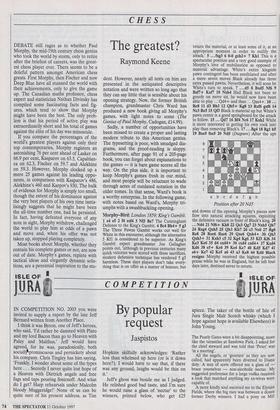CHESS
DEBATE still rages as to whether Paul Morphy, the mid-19th century chess genius who took the world by storm, only to retire after the briefest of careers, was the great- est chess player ever. There seems to be a doleful pattern amongst American chess greats. First Morphy, then Fischer and now Deep Blue have all stunned the world with their achievements, only to give the game up. The Canadian maths professor, chess expert and statistician Nathan Divinsky has compiled some fascinating facts and fig- ures, which tend to show that Morphy might have been the best. The only prob- lem is that his period of active play was extraordinarily short and his total of games against the elite of his day was minuscule.
If you compare the percentages of the world's greatest players against only their top contemporaries, Morphy registers an astonishing 76 per cent ahead of Lasker on 66.9 per cent, ICasparov on 63.5, Capablan- ca on 62.3, Fischer on 59.7 and Alekhine on 59.3. However, Morphy clocked up a mere 25 games against his leading oppo- nents, in comparison with Kasparov's 486, AleIthine's 460 and Karpov's 930. The bulk of evidence for Morphy is simply too small, though the extent of his dominance against the very best players of his own time tanta- lisingly suggests that he might have been the all-time number one, had he persisted. In fact, having defeated everyone of any note in sight, Morphy withdrew, challenged the world to play him at odds of a pawn and move and, when his offer was not taken up, stopped playing completely.
Most books about Morphy, whether they contain his complete games or not, are now out of date. Morphy's games, replete with tactical ideas and elegantly dynamic solu- tions, are a perennial inspiration to the stu-
The greatest?
Raymond Keene
dent. However, nearly all texts on him are presented in the antiquated descriptive notation and were written so long ago that they can say little that is sensible about his opening strategy. Now, the former British champion, grandmaster Chris Ward has produced a new book giving all Morphy's games, with light notes to some (The Genius of Paul Morphy, Cadogan, £14.99).
Sadly, a number of opportunities have been missed to create a proper and lasting modem tribute to this American genius. The typesetting is poor, with smudged dia- grams, and the proof-reading is sloppy. Furthermore, after page 91 of a 205-page book, you can forget about explanations to the games — it is bare game scores all the way. On the plus side, it is important to keep Morphy's games fresh in our, mind, and most people will be reluctant to wade through acres of outdated notation in the older tomes. In that sense, Ward's book is a worthy enterprise. In the following game, with notes based on Ward's, Morphy tri- umphs with a swashbuckling opening.
Morphy–Bird: London 1859; King's Gambit, 1 e4 e5 2 f4 exf4 3 NO Be7 The Cunningham Defence to the King's Gambit. 4 Bc4 Bh4+ 5 g3 The Three Pawns Gambit works out well for White in this encounter, although the alternative 5 Kfl is considered to be superior. As King's Gambit expert grandmaster Joe Gallagher points out, 'although in previous centuries many quick victories were scored with these sacrifices, modern defensive technique has rendered 5 g3 harmless. These days players don't take every- thing that is on offer as a matter of honour, but return the material, or at least some of it, at an appropriate moment in order to nullify the attack.' 5 ... fxg3 6 0-0 gth2+ 7 Khl This is a spectacular position and a very good example of Morphy's love of mobilisation as opposed to material advantage. White's entire kingside pawn contingent has been annihilated and after a mere seven moves Black already has three extra passed pawns. Nevertheless, it will soon be White's turn to speak. 7 ...d5 8 Bxd5 Nf6 9 Bxf7+ ICxf7 10 Nxh4 Had Black not been so greedy on move six, he would now have been able to play ... Qd4+ and then ... Qxe4 + . 10 ... Re8 11 d3 Bh3 12 Qh5+ Kg8 13 Rxf6 gxf6 14 Ne3 Re5 15 Qf3 Black is material up but White's pawn centre is a good springboard for the attack to follow. 15 ...Qd7 16 Bf4 Nc6 17 Kxh2 White is more interested in getting his own rook into play than removing Black's. 17 ...Bg4 18 Rgl h5 19 Bxe5 fxe5 20 Nd5 (Diagram) After the ups
and downs of the opening Morphy's pieces now flow into natural attacking squares, exploiting the defensive vacuum in front of Black's king. 20 ...Nd4 21 Nf6+ Kh8 22 Qe3 Qg7 23 Nxh5 Qh/ 24 Rxg4 Qxh5 25 Qh3 ICh7 26 c3 Ne6 27 Rg6 Re8 28 Rxe6 Rxe6 29 Qxe6 Qich4+ 30 Qh3 Qxh3 + 31 Kxh3 c5 32 Kg4 Kg6 33 1(13 Kf6 34 Ke3 Ke6 35 d4 exd4+ 36 cxd4 cxd4+ 37 Kxd4 Kd6 38 e5+ Ke6 39 Ke4 Ke7 40 Kd5 Kd7 41 e6+ Ke7 42 Ke5 a6 43 a3 Ke8 44 Kd6 Black resigns Morphy received the highest possible praise while he was in England, but he left four days later, destined never to return.


















































































 Previous page
Previous page